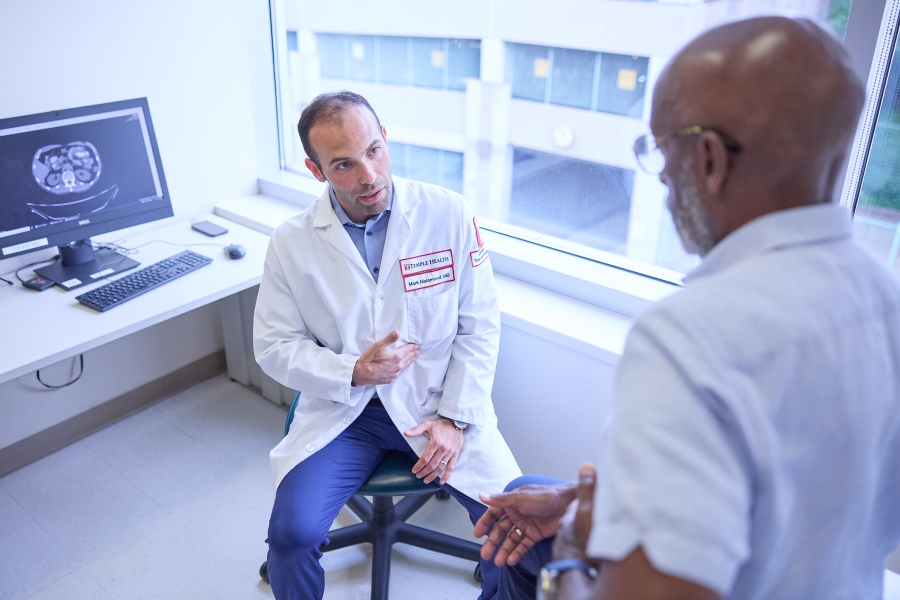Overcoming Superior Semicircular Canal Dehiscence Syndrome
When an Inner-Ear Problem Brought This Extreme Athlete to His Knees, He Turned to Temple for Help.
There was a time when Doug Black, Jr. could hear a pin drop. Or a cell phone ring, two floors above him. Or a faucet dripping, one floor below. Or his eyeballs move.
“I was hearing things that no one should be hearing,” says the 35-yearold Philadelphia resident. By day, he manages a homeless shelter. By night, he trains to be a “ninja warrior” athlete, and plays with his two young daughters—both activities made agonizing by his suddenly super sensitive hearing, which first cropped up on Father’s Day in 2013.
“I was playing guitar at church and just felt like lightning shot down my spine and I collapsed,” he recalls. “The whole world was wobbly.” A trip to the doctor showed that, fortunately, Black hadn’t had a stroke, and follow-up doctor visits suggested everything was normal while his hearing was more acute than normal.
Which seems like a blessing, but turned out to be a heavy curse. “Normal sounds were excruciating, and loud sounds were torture,” Black explains. “My kids always had to be quiet. I had to walk around the house with air-traffic earmuffs, but it was still painful.”
Discomfort from the slightest sound wasn’t the only problem. Black also experienced increasingly frequent and serious bouts of vertigo and nausea.
At the gym, he fell off a wall and got pretty scraped up; at work, he was dizzy enough to fall multiple times in a day.
Black spent two long years bearing the unbearable, despite seeking medical assistance: “The first doctor I went to stated there was nothing he could do, and said, ‘Good luck.’” Finally, he Googled his symptoms and stumbled upon the answer: superior semicircular canal dehiscence syndrome, the lack of bone over one of the inner ear’s canals. That same day, Black also found the doctor who would ultimately cure him: Pamela C. Roehm, MD, PhD, Director of Temple University Hospital’s Division of Otology & Neurotology and Associate Professor of Otolaryngology–Head & Neck Surgery at the Lewis Katz School of Medicine at Temple University (LKSOM).
She has plenty of experience treating the syndrome, which affects less than two percent of the population. It occurs when an injury, surgery, or pressure inside the skull causes a tear in the bone over the superior semicircular canal, one of three inner ear canals on each side of the head. “They work together to let you know where your head is in three-dimensional space and if you are turning or spinning,” explains Dr. Roehm. In some cases, like Doug’s, these bones are just naturally thin, and all it takes is a sudden blow or disruption to set off the syndrome’s symptoms.
Testing showed that Black’s right ear had the condition, which has only been recognized among physicians for about 20 years. “It was very relieving to know something was actually wrong with me,” he says, after so much suffering and so many other people thinking he was crazy. Not all doctors or even ear specialists know of the condition, points out Roehm: “Even if you have been told there is nothing that can be done for your tinnitus [ringing in the ears] or dizziness, it can be worthwhile to get a second opinion.”
Receiving the diagnosis was only half of the solution, though. According to Roehm, leaving the condition untreated could worsen the symptoms. Black had to contend with the idea of intracranial surgery—drilling a hole in his skull, pulling back the brain, and fixing the broken bone. But there wasn’t much doubt in his mind: “I basically told her I don’t have a life, I walk and live as a zombie, every moment in excruciating pain with the world spinning.”
So last August, Black underwent surgery at Temple University Hospital, conducted by Dr. Roehm and her colleague Kadir Erkmen, MD, FAANS, Director of Cerebrovascular Neurosurgery and the Neurosurgery Residency Program, as well as Associate Professor of Neurosurgery at LKSOM. The operation revealed not only the break that was causing Black’s symptoms, but also that his skull had deteriorated so much “you could see through it;” the thinning parts had to be reinforced with bone harvested from elsewhere in his skull.
Upon awakening six hours later, Black could hear—but finally, for the first time in a long time, normally and without pain. He was shocked by how peaceful everything seemed, even in a hospital bed with numerous noisy monitors and alarms, and gets emotional, tearing up just describing it: “After two years of hearing every single sound, the whole world was so quiet.”
Black credits his care team for making the experience as pleasant as possible. “Dr. Roehm was so caring and so patient, taking the time to explain everything and instilling in me a real confidence that this could be fixed,” he comments. “And Dr. Erkmen was so calm and collected, which was really reassuring. Even the day of surgery, he said, ‘You’ll be climbing walls in no time!’”
Indeed, Black is now back to his active self. His symptoms are gone and should stay that way. “It’s like a new normal,” he notes. “The world stays in line and things sound normal.”
And after months of recovery—which included retraining himself to walk without compensating for the dizziness that used to rule his life—he’s back to the gym and pushing himself to possibly compete in the American Ninja Warrior trials. The training “forces you to do stuff your mom told you not to do,” Black laughs. “You really conquer your fears and push yourself to places you didn’t think were possible.”
After all he’s been through, to watch Black just gleefully swinging along a set of monkey bars or running up a wall is to know that “impossible” doesn’t apply to him. With the help of Temple clinicians and his never-give-up spirit, he has proven himself to be a true warrior.
